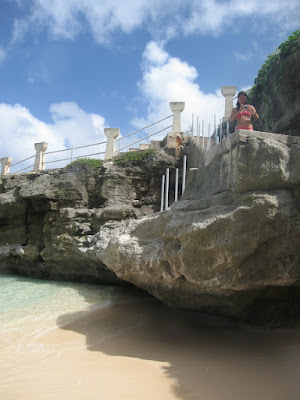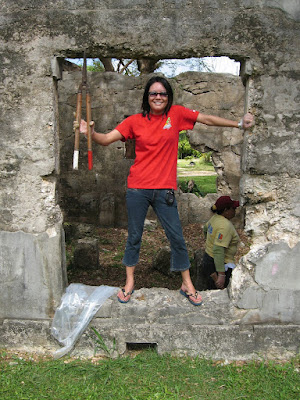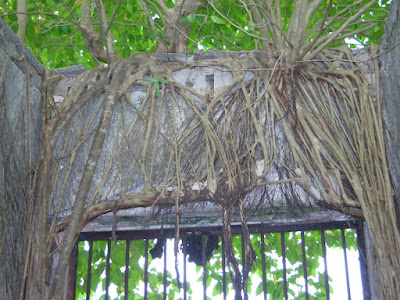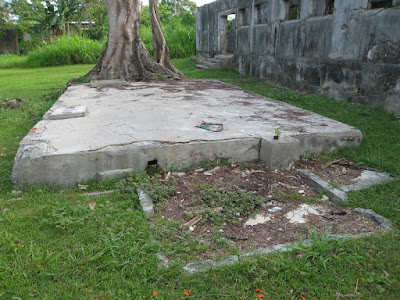New York Times, April 17, 2007No-Fishing Zones in Tropics Yield Fast Payoffs for Reefs
 By CHRISTOPHER PALAPublished: April 17, 2007
By CHRISTOPHER PALAPublished: April 17, 2007
NGIWAL, Palau — Sitting on a bench in a thatched hut in this village on Palau’s main island of Babeldaob, Islias Yano, 57, looked over the bay he has fished professionally since he was 15 and recalled the fishing practices of his boyhood.

“We fished certain fish in certain seasons,” he recalled. “Each reef could only be fished by people from a certain village.” Village elders would rotate fishing on reefs, he recounted, to husband their slow-growing main source of food.
Starting in the 1980s, population growth, new seafood markets in Asia and modern ways of thinking washed away the elders’ authority and rules.
“Outsiders started coming into our reefs, they used scuba gear and dynamite, and the fish got smaller and fewer,” Mr. Yano said, shaking his head.
In the world’s tropical seas, full-grown snappers and groupers became as rare as full-grown tuna or cod elsewhere. In Ngiwal, the reaction was not long in coming. Once again, the elders ruled.
In 1994, they banned fishing in a small area of reef that was partly accessible on foot. The village women, who traditionally gather shellfish at low tide, noticed how the fish became more plentiful there in a few years. The reef became locally famous, and other villages started to do the same.
Today, Palau, a tiny island state 600 miles east of the Philippines that is internationally known as a site for recreational diving, is at the forefront of a worldwide movement to ban fishing in key reefs to allow the return of prized species. It now protects a patchwork of reefs and lagoon waters amounting to 460 square miles.
At a November 2005 meeting of the United States Coral Reef Task force in Koror (the Republic of Palau, independent since 1994, still qualifies for certain domestic financing from the United States), President Tommy Remengesau Jr., probably the world’s most conservation-minded head of state, caused a splash with his so-called Micronesian Challenge: a call to the rest of the region to set aside for conservation 30 percent of coastal waters and 20 percent of the land area by 2020. Palau already has that amount, though not all of it is policed, but the rest of the region has far less.
“I realized you couldn’t have development on one side and conservation on the other, and see which would outwit the other,” he said an in interview in Koror, the commercial capital. “If you cared for the future of the country, you had to bring them together,” so the nongovernmental organizations became “an integral part of our planning.”
Palau’s challenge has come at a time when reef-fishing communities around the world are discovering that setting aside no-fishing areas yields dividends in a few years because the resurgent fish populations spill over into areas where fishing is allowed.
Without as much support from their national government as Palauans enjoy, local authorities in Fiji have raised the number of no-take zones to 189 from 2 in 10 years.
Two years after Ratu Aisea Katonivere, a traditional chief, imposed a no-take zone, “The fish are closer and bigger,” he said. “They are coming back; it’s a miracle.” Mr. Katonivere, who rules over 7,000 people in the Great Sea Reef, the world’s third-largest barrier reef, spoke in an interview during a conservation conference in Honolulu.
Other participants said that in the Solomon Islands, the protected areas have gone to 30 from 2 in just five years, and in Vanuatu, they exceed 100.
“The old system of controlling fishing with the taboo system is being adapted and improved because people still respect their traditional chiefs,” said Alifereti Tawake of the University of the South Pacific in Fiji. “They’re used to fishing where they want, but when they see the decline of the fish and the results of the no-take areas, they see it’s the way to go.”
The Micronesia Challenge has resonated far beyond Micronesia. Five months after Mr. Remengesau issued it, President Susilo Bangbang Yudhoyono of Indonesia pledged to increase marine protected areas to 24.7 million acres from 18 million acres by 2010. In the Antilles, the states of Grenada, the Bahamas, Belize and the Grenadines, which have already protected some reef areas, have committed themselves to a Caribbean Challenge and are trying to persuade the other nations to make similar pledges, according to Bill Raynor, the Nature Conservancy’s director for Micronesia.
But in the United States, marine protected areas are less than 1 percent of near-shore waters. In Hawaii, where the reefs are largely depleted of fish, a “right to fish” bill recently approved by the state house of representatives would make it almost impossible to create any protected areas by requiring unattainable scientific data.
That Palau has taken the lead in ocean conservation is no accident. Even among Pacific peoples, Palauans have been known for prizing fish and seafood over meat and farmed vegetables, and its fishermen have stood out for their keen understanding of the reefs. A Canadian marine biologist, Robert E. Johannes, was the first to tap the Palauans’ knowledge of marine biology by interviewing them and fishing with them in the 1970s.

Palauans, he wrote, showed him that in their archipelago, 55 species of edible fish followed the lunar calendar to gather in enormous groups called spawning aggregations and release sperm and eggs in the water — “more than twice as many species as biologists had described for the whole world.”
When diving became popular, in the 1990s, Palauan fishermen were able to take foreigners to sites with extraordinary numbers and varieties of fishes and corals, and the island became one of the world’s top diving destinations. This brought a measure of prosperity to the 14,000 Palauans (unemployment is 2.9 percent), and it reinforced the views of fishermen like Mr. Yano that plundering reefs is a bad idea. In 1997, 330 square miles in the Rock Islands lagoon favored by divers were closed to commercial fishing and the killing of sharks anywhere in Palau’s waters was banned.
Also protected are the Napoleon wrasses, fish that can reach five feet and are worth up to $10,000 alive in Hong Kong. They have been decimated almost everywhere else, but Palau now boasts one of the world’s largest densities of them, a major attraction for divers.
In 1998, a so-called El Niño event involving major sea current changes sent unusually warm water to several countries around the world, causing the corals there to turn white and die. In Palau, the bleaching event killed off a third of its corals on average, but the proportion was much larger in the outer reefs whose dense fish populations, clear water and dramatic drop-offs are the main attractions to divers.
At the time, Noah Idechong, the country’s leading environmentalist and founder of the Palau Conservation Society, had recently been elected to the lower house of Parliament.
“We realized that our no-fishing areas could not protect us from global warming and reef bleaching,” he said.
With the support of the Nature Conservancy, Mr. Idechong (pronounced idda-ONG) introduced legislation to integrate the patchwork of existing protected areas— some imposed by the government for tourism, others established by villages along the coast — and add another 30 percent from those that best resisted bleaching, or recovered fastest from it, he said.
Today, the network design is close to being completed, and by the end of the decade — 10 years before the president’s 2020 pledge — it should be fully in place, Mr. Idechong said.
Although Palau’s reefs are the envy of the region, poaching remains a problem. “There are boats on my reef every night; they are fishing illegally with scuba tanks and spear guns,” fumed Brownie Salvador, the governor of Ngarchelong State. “I have no money to hire rangers to stop them.”
To monitor the health of the reefs and curb poaching, Palau needs $2.1 million a year, officials say. Foreign donors are expected to create a $12 million trust fund, and the rest will come from an added tax on divers, said Mr. Raynor of the Nature Conservancy, in an interview in Pohnpei, in the Federated States of Micronesia.
Because Palau is far ahead of the others, “It’s really important we succeed, because the whole world is looking at us,” Mr. Raynor added.
At Dalhousie University in Nova Scotia, Boris Worm, author of a seminal paper predicting that there will be little wild fish left to eat by midcentury, is keeping a close eye on the rapid spread of marine-protected areas in the Pacific. “Those bottom-up ones work a lot better than top-down ones; they have better compliance and work well long-term,” Dr. Worm said. “Now that we are reaching a global limit, people are asking how can we fix the problem, and they are rediscovering that the old methods really work. It’s very significant.”
 Flame Tree Adoptions: MINA Board member Chuck Sayon, Nancy Rushmer, Rep. Cinta Kaipat, and Doreen Jesus of Guam pose with some of the Adopt-a-Flame Trees.
Flame Tree Adoptions: MINA Board member Chuck Sayon, Nancy Rushmer, Rep. Cinta Kaipat, and Doreen Jesus of Guam pose with some of the Adopt-a-Flame Trees.




















































